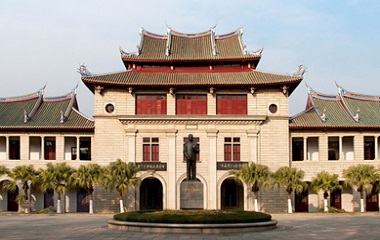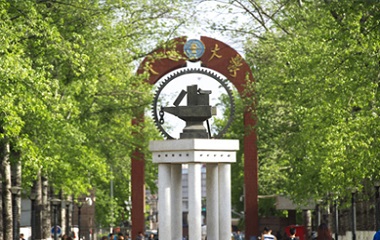[Cameroon] Foussie Minche Mohamed Salim, Guilin University of Technology
The Poetic Dance: The Journey of a Legend Landscape Painting performed on the stage of the China Central Television’s 2022 Spring Festival Gala goes viral.
The “green-color landscape” on the small screen reminds me of Guilin, the city where I studied. I will never forget the beautiful landscape of the city.

On a spring afternoon, a Chinese friend took me to a place called Xianrentai, or Terrace of Gods, which turns out to be the right way to open the landscape of Guilin. Xianrentai is located on an unnamed mountain in Putao Township, Yangshuo County. Follow a trail trodden by tourists and photographers and climb up the hill, and you’ll see greenery before your eyes. The graceful and varied peaks are dark green; the clear, sparkling Lijiang River is turquoise, making a big U-turn and continuing to wind through the mountains.
The flora that thrives and sprouts in spring is tender green in the breeze, nodding with a smile; even the clouds that linger in this azure water and green hills seem to be imprinted with a faint mint green that won’t dissipate for a long time. It is so deserted and tranquil that even the whistles of the cruise ships on the Lijiang River have been muted. No wonder this place is called Terrace of Gods, although you can’t see the gods, you can see the fairyland that only immortals can see. At this moment I just want to open my arms to embrace the beauty in front of me and sing the song called “Folk Songs are like River Water in the Spring”…

To be honest, I was disappointed with Guilin when I first arrived. In my imagination, Chinese cities were supposed to be modern metropolises with skyscrapers just like Beijing, Shanghai and Guangzhou. But after arriving in Guilin, I found that it was a different story. It is hard to relate the narrow streets and low-rise buildings in Guilin to a “modern city.” My teacher later explained that Guilin is a tourist city famous for its “Guilin landscape” among numerous tourists. In order to protect the original landscape of Guilin from being overshadowed by tall buildings, the city’s government has stipulated that the maximum height of buildings in the urban area should not exceed 24 metres. Oh, so it is.

The people of Guilin have chosen to give up tall buildings in order to preserve the greenery of the Guilin landscape. As you stroll through the streets of Guilin, you stand on the Jiefang Bridge, under which is the flowing Lijiang River. Not far from the bridge is the Elephant Mountain, which is sticking its huge trunk into the Lijiang River, quietly sipping the refreshing river water at its edge. In the distance, you can see both the Chuanshan Hill and Tashan Hill. Climbing up to the Xiaoyao Building and looking out across the river, the seven peaks of the Seven Star Park have stood there for thousands of years, witnessing the prosperity and vicissitudes of this small city.
Standing on top of the Diecai Mountain, you will find that Guilin’s natural scenery and cultural architecture are so harmonious. Dotted in the large green natural landscape, there are gray, white and red buildings arranged in an orderly manner like a matchbox. Not only does it not damage the natural scenery, but it adds some hustle and bustle to the natural green. Like the pavilions and pagodas in a Chinese landscape painting, the appearance of fishermen and woodcutters is not abrupt, but rather adds the touch that brings the painting to life.

Roaming around Guilin is a pleasure. There are shared bicycles everywhere on the streets, so you can scan the code with your smart phone, and instantly have a little yellow or blue bike. As you ride around Guilin, the tinkling of the bell echoes through the streets. The streets of Guilin are not noisy as most of the cars on the streets are electric with green plates, and even the buses are electric. The concept of green travel has long been ingrained in the lives of Guilin people.
Binjiang Road is one of my favourite roads to stroll along. The pavements on both sides of the road are lined with two rows of lush camphor trees. The canopies of these trees are like big green umbrellas, shading the whole riverfront road from the scorching sunlight and heat wave. Due to the good air, the thick trunks of the trees are covered with moss and vine plants, as if the trees have green fuzz growing on them. Walking in the green shade of Binjiang Road and breathing in the fresh air is so refreshing and invigorating. To the east of the riverfront is the world-famous Lijiang River. Once I was walking along the road and was fascinated by a group of people along the Lijiang River.
There were about 30 or 40 of them, all wearing green vests. Some of them are old people, some are young people and children. With a long fire poker in one hand and a plastic bucket in the other, they slowly walked along the river bank, picking up something and putting it into the plastic bucket. Curious, I went over and asked, “What are you doing?”
“We’re cleaning up the rubbish by the Lijiang River.”
“Why are you doing this?”
“The Lijiang River is our mother river, who has raised Guilin people. As Guilin people, we have a responsibility and an obligation to protect our mother river!”
Looking at their moving green backs, I finally understood why the Lijiang River is so crystal clear and why this mountain is so green. Because there are so many people who love her and are watching over her.

When Chinese President Xi Jinping visited Guilin last year, he said, “We must take good care of the beautiful landscape, which is a treasure given by the nature to the Chinese nation. We must protect it, which is the first priority.” These words speak to the heart of Guilin people, and I think it is because of this original aspiration that enables Guilin chooses “its green.”
The story is from "My Beautiful Encounter with China" Essay Competition organized by the Chinese Service Center for Scholarly Exchanges (CSCSE).










